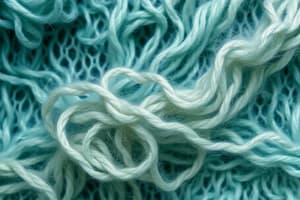Podcast
Questions and Answers
What is the main component of cotton fibers?
What is the main component of cotton fibers?
Cellulose
Which type of animal protein is silk composed of?
Which type of animal protein is silk composed of?
Fibroin
What is the main polymer used in the production of polyester fibers?
What is the main polymer used in the production of polyester fibers?
Polyethylene terephthalate (PET)
Which synthetic fiber is known for its strength and elasticity?
Which synthetic fiber is known for its strength and elasticity?
What is the main property of acrylic fibers that makes them desirable in textiles?
What is the main property of acrylic fibers that makes them desirable in textiles?
What is the purpose of weaving machines in the textile industry?
What is the purpose of weaving machines in the textile industry?
How are synthetic fibers typically manufactured?
How are synthetic fibers typically manufactured?
Explain the difference between woven and knitted fabrics.
Explain the difference between woven and knitted fabrics.
What does the term 'tensile strength' refer to in relation to fabrics?
What does the term 'tensile strength' refer to in relation to fabrics?
How are natural fibers typically sourced in the textile industry?
How are natural fibers typically sourced in the textile industry?
Flashcards are hidden until you start studying
Study Notes
Fibers to Fabric: From Natural to Synthetic
Your curiosity about the science behind turning fibers into fabrics is about to be fueled by a whirlwind tour through the processes, materials, and properties that make up our textile world.
Natural Fibers
Natural fibers, derived from living organisms, have been used for thousands of years. Some of the most common include:
- Cotton: A versatile fiber extracted from the cotton plant, consisting mainly of cellulose.
- Wool: Soft fibers sheared from sheep, goats, or other animals, made up of a protein called keratin.
- Silk: Produced by silkworms, composed of an animal protein called fibroin.
- Linen: Derived from the flax plant, made up of cellulose fibers.
- Rayon (viscose): A semi-synthetic fiber originating from natural cellulose, derived from wood pulp.
Synthetic Fibers
While natural fibers are as old as agriculture, synthetic fibers have only been around since the 20th century and are made from petroleum or other chemical sources.
- Polyester: A fiber made from the polymer polyethylene terephthalate (PET), used in a variety of applications.
- Nylon: Composed of polyamide, a type of polymer, nylon is known for its strength and elasticity.
- Polypropylene: A thermoplastic polymer used in various applications, including textiles.
- Acrylic: A synthetic fiber made from polyacrylonitrile, known for its warmth and moisture resistance.
Weaving Process
Fibers are spun into yarns and then woven into fabrics using weaving machines, such as shuttle looms, air-jet looms, or rapier looms, depending on the desired fabric qualities. Looms interlace warp and weft threads to form a woven cloth.
Spinning Process
Fibers are spun into yarns using spinning machines, such as flyer spinning or rotator spinning, to create long, continuous yarns. The spinning process also involves twisting or drawing fibers together to create a strong, cohesive yarn.
Sources of Fibers
Natural fibers are typically sourced from plants, animals, or their byproducts. Synthetic fibers are made from petroleum or other chemical sources.
Types of Fabrics
Textiles are grouped into several categories based on their properties and uses. Some examples include:
- Woven: Fabrics created with a combination of warp and weft yarns, such as cotton, linen, and polyester.
- Knitted: Fabrics made using a looping technique, such as jersey, interlock, or ribbed knit.
- Nonwoven: Fabrics made by bonding fibers together, such as spunbond, meltblown, or wetlaid nonwovens.
Properties of Fabrics
Fabrics are characterized by various properties, including:
- Breathability: The ability of a fabric to allow air and moisture to pass through it.
- Tensile strength: The fabric's resistance to breaking when stretched.
- Elasticity: The fabric's ability to return to its original shape after being stretched.
- Durability: The fabric's resistance to wear and tear.
- Wrinkle resistance: The fabric's resistance to wrinkling.
- Colorfastness: The fabric's resistance to bleeding or fading during washing or exposure to light.
While our focus here is on the science of textiles, the applications and creative possibilities in fashion, design, and technological innovation are endless, providing excellent opportunities for exploration and discovery.
Studying That Suits You
Use AI to generate personalized quizzes and flashcards to suit your learning preferences.




